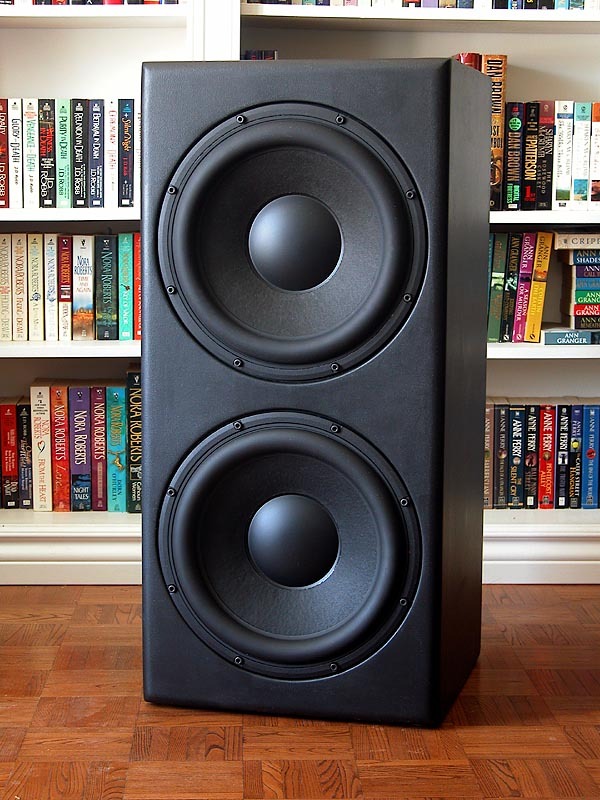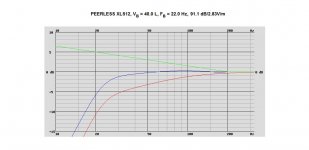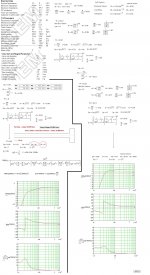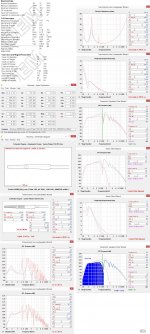can someone tell me is the boxes recommend by peerless are the best that i can do for this driver 12inch xls long throw .
the last one i built was designed by a long time member named rabbitz
the last one i built was designed by a long time member named rabbitz
Well, it always depends on the needs of the app, but as a general rule it's true for these drivers with the caveat that you may need to fine tune a PR loaded cab; just don't presume from this that it's true for other Peerless models, brands.
GM
GM
thanks for the reply GM
in is going to be used mainly for home theater . but it would be nice to have a box that can do double duty music & theater
in is going to be used mainly for home theater . but it would be nice to have a box that can do double duty music & theater
can someone tell me is the boxes recommend by peerless are the best that i can do for this driver 12inch xls long throw .
the last one i built was designed by a long time member named rabbitz
First we need to know exactly what driver you have.
12″ Subwoofer XLS 830500 (v2009)
12″ Subwoofer XLS P830500 (v2010)
Then in this reference sheet link they mention 3 design types of enclosures, and your design/alignment maybe is similar to one of them I suppose and/or may differ from it in what your intention/purpose is. Please make mention of the design you have reflex, other and volume in liters/tunning... or dimensions (net).
Application note for Peerless XLS 12" 830500 - pdf
Last edited:
Sealed enclosure: data is given in the "Application note for Peerless XLS 12" 830500 - pdf" if for a sub you want to have a good response at 25 Hz with boosting and equalization, what might not be enough with a good amplifier (as stated), maybe with room gain and extra XXL sealed enclosure ""...even with a very powerful amplifier of 300 W it is not possible to achieve over 100 dB at 25 Hz. Using a larger cabinet or counting on the bass boost of all living room environments with the boundaries contributing to amplification of the lowest frequencies a very good transient response can be achieved with the sealed enclosure.""
Vented: the problem here is that the natural (read ideal) enclosure for this driver is very small in the order of 20L. And with that enclosure you don't go to sub territory.
With an extra sized/sub like enclosure adapted to this driver the response goes down about 5dB or 10dB at 30Hz and 20Hz so you need to be careful in the design you choose. Also the size of the ports is large for a good power handling and very-very long ones (constraints). You can adapt and maximize this data depending of your interest objectives. The best way is to model your driver in the right enclosure, or in the enclosure you have and model the port accordingly. (Software: WinISD, other...)
I'm going to model an enclosure (#1) and after that I'm going to compare to next-of-kin in the data sheet (#2) for your information. You have to recognize that you are not giving any, what is of any help, putting the work load on our side (read below). 😀
What speaker type do you have. Size/volume (describe with numbers). What port do you have (again describe with numbers), so that we are compare apples with apples. 🙂
Have no idea what you have in mind or the speaker you have in front of you. 😉
#1) I model a reflex speaker/sub for the XLS12, VB = 40.0 L/FB = 20.0 Hz, with response to lower 20Hz, this with some relative attenuation, 85 dB/2.83V/m@30Hz (sensitivity). This speaker can handle *500W@4Ohms with max excursion 12.5 mm (Xmax) standard for this driver. The ports are 2x of 5.7 cm internal diameter and extra length of about 90 cm. *Note that power of about 300W will have smaller and shorter port for the same excursion/tuning (Xmax).
#2) Reflex (data sheet):
Vented cabinet data:
Total volume: 40 litre
Port diameter: 90 mm (double flared recommended)
Port length: 510 mm
Tuning frequency: 30 Hz
High pass filter (highly recommended):
Q: 0.7
Fo: 20 Hz
Conclusion: The port for the #2 enclosure is well adapted for the power (~300W) with flaring ""Port diameter: 90 mm (double flared recommended"".
The tuning is very high considering various factors. XLS12, VB = 40.0 L/FB = 30.0 Hz.
Your F6 is 28 Hz what is considerably high for a sub, and comparing with the previous sub (#1) alignment gives 81 dB/2.83V/m@25Hz. As in the datasheet information a high pass might be necessary.
Excursion is much higher with a higher tuning like in this case @30Hz (#2) vs. @20Hz (#1). This is only important when using (abusing) of maximum power >300W RMS.
I would consider a more adequate intermediary alignment (as a starting point for a possible project): XLS12, VB = 40.0 L/FB = 25.0 Hz to 22Hz. This, with a room gain of 1/1.5 dB@200Hz (room dependent) gives almost a flat frequency range to 25Hz (-3dB) (blue: response with 1.5dB room gain.)
Vented: the problem here is that the natural (read ideal) enclosure for this driver is very small in the order of 20L. And with that enclosure you don't go to sub territory.
With an extra sized/sub like enclosure adapted to this driver the response goes down about 5dB or 10dB at 30Hz and 20Hz so you need to be careful in the design you choose. Also the size of the ports is large for a good power handling and very-very long ones (constraints). You can adapt and maximize this data depending of your interest objectives. The best way is to model your driver in the right enclosure, or in the enclosure you have and model the port accordingly. (Software: WinISD, other...)
I'm going to model an enclosure (#1) and after that I'm going to compare to next-of-kin in the data sheet (#2) for your information. You have to recognize that you are not giving any, what is of any help, putting the work load on our side (read below). 😀
What speaker type do you have. Size/volume (describe with numbers). What port do you have (again describe with numbers), so that we are compare apples with apples. 🙂
Have no idea what you have in mind or the speaker you have in front of you. 😉
#1) I model a reflex speaker/sub for the XLS12, VB = 40.0 L/FB = 20.0 Hz, with response to lower 20Hz, this with some relative attenuation, 85 dB/2.83V/m@30Hz (sensitivity). This speaker can handle *500W@4Ohms with max excursion 12.5 mm (Xmax) standard for this driver. The ports are 2x of 5.7 cm internal diameter and extra length of about 90 cm. *Note that power of about 300W will have smaller and shorter port for the same excursion/tuning (Xmax).
#2) Reflex (data sheet):
Vented cabinet data:
Total volume: 40 litre
Port diameter: 90 mm (double flared recommended)
Port length: 510 mm
Tuning frequency: 30 Hz
High pass filter (highly recommended):
Q: 0.7
Fo: 20 Hz
Conclusion: The port for the #2 enclosure is well adapted for the power (~300W) with flaring ""Port diameter: 90 mm (double flared recommended"".
The tuning is very high considering various factors. XLS12, VB = 40.0 L/FB = 30.0 Hz.
Your F6 is 28 Hz what is considerably high for a sub, and comparing with the previous sub (#1) alignment gives 81 dB/2.83V/m@25Hz. As in the datasheet information a high pass might be necessary.
Excursion is much higher with a higher tuning like in this case @30Hz (#2) vs. @20Hz (#1). This is only important when using (abusing) of maximum power >300W RMS.
I would consider a more adequate intermediary alignment (as a starting point for a possible project): XLS12, VB = 40.0 L/FB = 25.0 Hz to 22Hz. This, with a room gain of 1/1.5 dB@200Hz (room dependent) gives almost a flat frequency range to 25Hz (-3dB) (blue: response with 1.5dB room gain.)
Attachments
Last edited:
There is a design that works well for both, it's been around for a fairly long time and uses the 830500 and the match peerless PR(no longer available) in a 35-40 liter enclosure.
F3 is in the low 20Hz range and it is both extremely smooth and has great transient response ie: ideal for both music and HT
There is a PR still available from Scan Speak Model 30w0-00-0 that is virtually an exact match spec and looks wise for the nla Peerless PR
Here is a picture of what my version of the final design looks like

F3 is in the low 20Hz range and it is both extremely smooth and has great transient response ie: ideal for both music and HT
There is a PR still available from Scan Speak Model 30w0-00-0 that is virtually an exact match spec and looks wise for the nla Peerless PR
Here is a picture of what my version of the final design looks like

thanks for the reply Inductor & corkwithlime if i did build a sub like your corkwithlime my wife would leave me
I think you are asking for the speakers are going to be in the room with is that right . if so my mains are 2 1/2 with vifa p17 & seas tweeters in a 40lt box tuned to 40 hz i would normally use both the mains & sub together for bass
I think you are asking for the speakers are going to be in the room with is that right . if so my mains are 2 1/2 with vifa p17 & seas tweeters in a 40lt box tuned to 40 hz i would normally use both the mains & sub together for bass
it is a 45ltr box it allows 3ltr for bracing & port . with fb 23hz f3 25hz
it is a 45ltr box it allows 3ltr for bracing & port . with fb 23hz f3 25hz
Hi busterno1,
Take a close look at the submitted Pictures:
b🙂
Attachments
I believe that the photo may be deceiving you - lolcorkwithlime if i did build a sub like your corkwithlime my wife would leave me
The actual enclosure external dimensions are only
30" high
14 1/2" wide
12 3/4" deep
Very small actually for a sub that can deliver 105dB @ 20 Hz while still being able to blend up to 500Hz(if you choose) with your mains
Last edited:
I really like this last TL design and the numbers with the -3 dB @16 Hz from bjorno-s last post.
But how to make the box for it exactly?
I know old tread, but the same driver I have and really don't wish to invest 130€+ sh for the SS 30W PR,
..... I had the 35 liter box with the PR from the first page, and loved it.
But how to make the box for it exactly?
I know old tread, but the same driver I have and really don't wish to invest 130€+ sh for the SS 30W PR,
..... I had the 35 liter box with the PR from the first page, and loved it.
Are you able to share the build details? I have 2 of these 12” XLS and matching PRsThere is a design that works well for both, it's been around for a fairly long time and uses the 830500 and the match peerless PR(no longer available) in a 35-40 liter enclosure.
F3 is in the low 20Hz range and it is both extremely smooth and has great transient response ie: ideal for both music and HT
There is a PR still available from Scan Speak Model 30w0-00-0 that is virtually an exact match spec and looks wise for the nla Peerless PR
Here is a picture of what my version of the final design looks like

Look up application notes for them from peerless. Make sure you have the correct 830500’s. The application note is for earlier 8ohm version.
- Home
- Loudspeakers
- Subwoofers
- Peerless 12 XLS box



